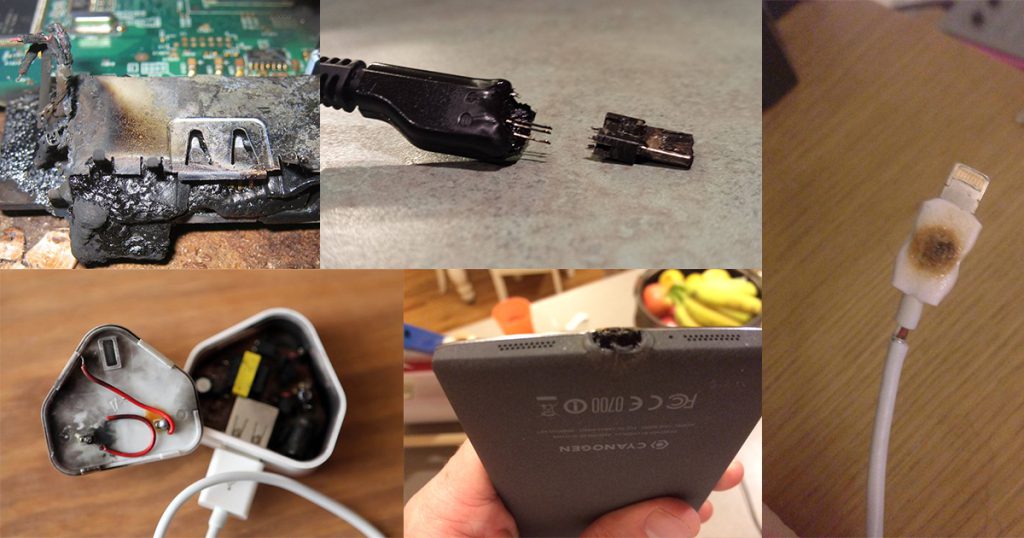The allure of cheap accessories for your smartphone and laptops for prices as low as 50 cents are irresistible, I know.
Whether it be a trip to Sim Lim Square or a nearby phone store, or shopping online on Qoo10 and Lazada, truth be told, most of us have bought them at least once in our lives.
But other than the fact that they spoil really easily, they might be slowly killing our devices too.
Cheap USB Cables Are Okay For Now (Sort Of)

Let’s not dive into all the cosmetic accessories like cases, skins, screen protectors and the like. Let’s face it, choices in these are entirely subjective and who are we to stop someone from pasting a $1 screen protector on a $1,000 iPhone.
The true danger though, lies in USB cables, the thing that you plug into your phone daily to charge it, or transfer data between it and your computer.
To be realistic, most people right now will not be that affected by cheap USB cables. This is because the devices they carry are mostly dependent on the USB 2.0 standard.
Just look at your phones right now.
If you are using an Android phone, you will find a micro USB port and that itself uses the USB 2.0 standard. No manufacturer is putting the 3.0 port because it takes up too much space, and the last time we saw a phone with a 3.0 micro USB port was on the Samsung Galaxy Note 3.
On the iPhone side of things, unless you are using the latest iPad Pro or the iPhone 7, your Apple devices are unfortunately limited to USB 2.0 speeds.
There Are Still Problems

We’re not preaching that it’s okay to use cheap USB cables, you just need to be aware of the dangers that come with it.
The most obvious downside would be the increased dip in performance in charging and data transfers.
A generic cable can also give your device a false positive, making it think that you are plugged into a computer when actually you are charging via a wall outlet, and will cause your phone to charge a lot slower.
While the old saying which states that it’s better to charge your phone slowly to preserve your battery still holds true, here’s the true danger. In the example above, we know that it already confuses your devices and that’s no accident.
That bit of confusion is one of the main culprits for equipment failure. The controllers and chips inside the devices that manage the power draw can be damaged with repeated use of those cables.
More than that, even before something gets fried and burnt, these cables might be eating away at perhaps the most important part of your device – the battery.
Why You Should Stop Using Them Now

We previously covered how USB Type-C is the new standard in the future of all mobility devices, and the good that it will bring into our increasingly active work schedules.
In summary, USB Type-C will not just give you data speeds which are 20 times more than USB 2.0, but it also draws more power, A LOT more of it.
A regular Type-C cable is able to deliver 3A of current, while higher spec ones go up to 5A. In retrospect, USB 2.0 can only support anywhere from 500mA up to 2A.
Now, here’s a fair warning in light of this new revolution because more than likely, your next phone or laptop will have a USB Type-C port for charging.
Type-C cables will now be subjected to loads of up to 10 times more current and as such, will require higher levels of manufacturing tolerances.

Cheap USB Type-C have become such a real problem ever since Google engineer Benson Leung published his findings after testing out a variety of cables, and even Amazon had stepped in and used the findings to ban the sale of USB Type-C cables that do not comply to recommended specifications.
As devices get more power hungry, the means through which that power is delivered into them becomes so much more important.
Just look at the Note 7.
While it’s not a USB cable issue, it’s an example where the volatile nature of a device’s battery can ruin a product.
Using non-compliant USB cables will degrade the components and battery of your devices, causing a potential scenario where the circuitry will one day just heat up and combust.
Not Just Cables Either

With so much news hating on cheap USB cables, one must also remember that the actual thing supplying the power to through the cables is equally important.
Many a time, people are put off by original chargers because of their high prices. Just look at Apple’s for instance – a typical iPhone charger costs close to $30 while an unbranded replica costs anywhere from $5 to $10.
While you may think that buying the cheaper one “as a spare” is a safe bet (much like buying cheap powerbanks) that decision could cost you more than just a phone or laptop.
Perhaps the parting message that we would like to give is that you should keep the purchase of “cheap” accessories limited to those that just improve aesthetics, but if it involves charging your phone, it might be better to spend that extra bit of cash for a peace of mind.
Also Read: [Infographics] Retrenchment in Singapore And What You Should Do If You’ve Been Let Go












